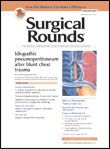Publication
Article
Surgical Rounds®
Carving the Fat from Patient Surgical Care
Author(s):
As a part of the Choosing Wisely campaign, 6 organizations representing surgeons have contributed lists of tests and procedures that can be unnecessary and a waste of money.

The cost of American healthcare is staggering, and, often, the bill is padded with unnecessary or even harmful tests, procedures, and prescriptions.
The Chicago-based ABIM Foundation worked with dozens of professional organizations and Consumer Reports in a project called Choosing Wisely to reduce waste in the healthcare system. A total of 58 professional organizations have joined them to create a list called Things Physicians and Providers Should Question, and 6 of these organizations represent surgeons.
In addition to the lists that advise surgeons’ healthcare colleagues, documents called Patient-Friendly Resources from Specialty Societies and Consumer Reports are also available to stimulate conversations that improve care and eliminate unnecessary tests and procedures.
Each list includes specific, evidence-based recommendations providers and patients should discuss to determine each individual patient’s most appropriate care. The lists cover unnecessary tests, procedures and drugs. The documents also describe the evidence (or lack thereof) that led to the recommendation.
Among the recommendations that come from the surgical experts are these:
- The Society of Thoracic Surgeons offers 5 faux pas starting with “Patients who have no cardiac history and good functional status do not require preoperative stress testing prior to non-cardiac thoracic surgery.” The society’s recommendations primarily focus on advising against testing performed in the absence of symptoms or risk factors. Find them here.
- The American Academy of Orthopaedic Surgeon’s list includes, “Don’t use glucosamine and chondroitin to treat patients with symptomatic osteoarthritis of the knee.” Its 5 “don’ts” tend to focus on interventions with no proven benefit. Find them here.
- From the American Academy of Otolaryngology — Head and Neck Surgery Foundation, physicians learn, “Don’t obtain computed tomography (CT) or magnetic resonance imaging (MRI) in patients with a primary complaint of hoarseness prior to examining the larynx.” The academy’s recommendations are split between inappropriate antibiotic use and inappropriate imaging. Find them here.
- The American Society of Plastic Surgeons advises, “Avoid performing routine and follow-up mammograms of reconstructed breasts after mastectomies.” Four of its 5 recommendations address breast surgery, and the fifth advises against plain X-rays (recommending CT scan instead) in facial trauma. Find them here.
- The American Association of Neurological Surgeons and Congress of Neurological Surgeons says, “Don’t routinely use seizure prophylaxis in patients following ischemic stroke,” because the evidence doesn’t support routine prophylaxis with antiepileptic drugs unless the patient has a seizure. Three of their recommendations address brain injury or aneurism, with the last targeting low back pain. Find them here.
- The American College of Surgeons (ACS) warns healthcare providers, “Don’t do computed tomography for the evaluation of suspected appendicitis in children until after ultrasound has been considered as an option.” The ACS’ other recommendations are the most varied of all the surgical organizations, and they can be found here.
The Choosing Wisely site also offers downloadable patient leaflets on chest x-rays, echocardiogram, heart imaging, lab tests, medical assessments and stress tests before surgery, advising patients that, often, these tests are superfluous.
The project reminds its audience that recommendations should not be used to establish coverage decisions or exclusions. The recommendations are guidelines to determine an appropriate treatment plan with input from the patient and the healthcare team.






